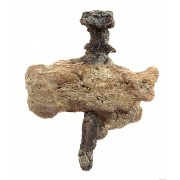Click here to listen to this article:
 Matthew 27:35 records the simple words: “Then they crucified Him, and divided His garments, casting lots” (NKJV). These few words record what was in the same moment the most horrific and yet most wondrous event this world has ever known. Yet what do we know about this? Do we really understand the scope of what Christ endured for us? The apostle Paul spoke of “the offense of the cross” (Gal. 5:11). The Roman statesman Cicero called crucifixion, “the most miserable and most painful punishment appropriate to slaves alone” (Against Verres, 2.5.169). Crucifixion was not considered an honorable way to die, and yet the Lord of all the universe poured out His life on a cross. My brother, Curtis Pope has suggested, “Knowledge of the process of crucifixion certainly adds profound meaning to Matthew 27:35 which in understated fashion simply mentions ‘when they had crucified Him’ to record the horrors” of the cross (“Taking Up the Cross,” 152). In this article and the next we will explore what it really means when the Holy Spirit tells us “they crucified Him.”
Matthew 27:35 records the simple words: “Then they crucified Him, and divided His garments, casting lots” (NKJV). These few words record what was in the same moment the most horrific and yet most wondrous event this world has ever known. Yet what do we know about this? Do we really understand the scope of what Christ endured for us? The apostle Paul spoke of “the offense of the cross” (Gal. 5:11). The Roman statesman Cicero called crucifixion, “the most miserable and most painful punishment appropriate to slaves alone” (Against Verres, 2.5.169). Crucifixion was not considered an honorable way to die, and yet the Lord of all the universe poured out His life on a cross. My brother, Curtis Pope has suggested, “Knowledge of the process of crucifixion certainly adds profound meaning to Matthew 27:35 which in understated fashion simply mentions ‘when they had crucified Him’ to record the horrors” of the cross (“Taking Up the Cross,” 152). In this article and the next we will explore what it really means when the Holy Spirit tells us “they crucified Him.”
 Roman Crucifixion
Roman Crucifixion
While the Romans certainly perfected its practice, they did not invent crucifixion. In the period between the Old and New Testament, the Seleucid king Antiochus Epiphanes practiced crucifixion (Josephus, Antiquities 12.5.4), and the Hasmonean ruler Alexander Jannaeus crucified 800 men (Ibid. 13.14.2). The Qumran text known as the Temple Scroll commands “hanging on wood” (thought to be an allusion to crucifixion) as the punishment for treason (11QTemple 64.6-13).
Roman crucifixion was usually carried out in three phases: flagellation (a severe scourging intended to weaken the victim); crucifixion (the actual binding of the victim to a cross); and finally, crurifragium (breaking the legs of the victim to hasten death) (Sava, “The Wound in the Side of Christ,” 343). Although flagellation (or scourging) could be administered alone, it was often the first stage of crucifixion. Lucian wrote of “those who died by the scourge and the cross” (Cataplus 6.18-20) or who “die by crucifixion or the scourge” (Juppiter Tragoedeus, 19). The severity of the scourging determined the time the victim spent on the cross. It is well attested that scourging often resulted in death (Horace, Satires 1.2.41; Seneca, On Mercy 1.15.1; Babylonian Talmud, Ketuboth 86b). Eusebius records accounts of witnesses to the scourging of Christians in the second century seeing their bodies torn to such a degree that their “entrails, and organs were exposed to sight” (Ecclesiastical History 4.15.4).
When a victim was finally put on the cross, crucifixion was usually a slow and lingering death. Horace described ravens feeding on the bodies that hung on a cross (Epistles. 1.16.48). Seneca wrote:
- Can anyone be found who would prefer wasting away in pain dying limb by limb, or letting out his life drop by drop, rather than expiring once for all? Can any man be found willing to be fastened to the accursed tree, long sickly, already deformed, swelling with ugly wounds on shoulders and chest, and drawing the breath of life amid long drawn-out agony? He would have many excuses for dying even before mounting the cross (Moral Epistles to Lucilius 101.14).
 The Instruments of Crucifixion
The Instruments of Crucifixion
There were different forms of crosses that were used. The most basic, the Romans called the crux simplex (or stipes) – I. This was a simple vertical stake to which a victim was nailed, tied or even impaled (Seneca, Moral Epistles to Lucilius 14.5). It is believed that the Romans first adopted the use of this form of punishment from the Phoenicians after the Punic wars.  The Romans had long practiced the custom of parading condemned men to their death bound to a wooden yoke called a patibulum (or furca). The Roman historian Livy describes a slaveholder punishing a condemned slave by driving him through the forum bearing a “yoke (furca)” and scourging him while he went (History of Rome 2.36.1). Plutarch describes the same custom, using the Greek word xulon used in Acts 5:30 of the “cross” (or “tree”) on which Jesus was hung (Coriolanus 24.5).
The Romans had long practiced the custom of parading condemned men to their death bound to a wooden yoke called a patibulum (or furca). The Roman historian Livy describes a slaveholder punishing a condemned slave by driving him through the forum bearing a “yoke (furca)” and scourging him while he went (History of Rome 2.36.1). Plutarch describes the same custom, using the Greek word xulon used in Acts 5:30 of the “cross” (or “tree”) on which Jesus was hung (Coriolanus 24.5).
The Romans combined the simple stake with the yoke or cross-beam to form the crux compacta, which could take several forms: the crux immissa (or capita) – †; the crux commissa (or tau) – T; and the crux decussata – X. The Roman poet Plautus described the combination of these two elements, describing a condemned man “with hands spread out and nailed to the patibulum” (Miles Gloriosus 2.4), and declaring of another, “let him bear the yoke (patibulum) through the city; then let him be nailed to the cross (crux)” (Fragments, Carbonaria fr. 2). The picture here is that of carrying the cross-beam, which would be attached to the upright when actually crucified. Ancient writers used the Greek words stauros and xulon (applied in the New Testament to the cross) of these same shapes of crosses (Lucian, Judicium Vocalium 12; Plutarch, On The Delays of Divine Vengeance 9; Epictetus, Discourses 3.26.22; LXX, Deut. 21:22-23; cf. 11QTemple 64.6-13).
The Form of Jesus’ Cross
The New Testament does not specify the form of cross on which Jesus was crucified, but it is likely that it was a cross-beam form of some type. Four second century writers support this conclusion. Ignatius speaks of the “rope” that draws one up to be “raised up” on a cross (Second Epistle to the Ephesians 14), possibly referring to raising a patibulum into place. Justin described Jesus’ cross as a beam set upright with a beam raised up to it (Dialogue 91). Tertulluan described Jesus’ cross as consisting of a “cross-beam (antenna)” and a “projecting seat (sedile)” (Ad Nationes 1.12; cf.  Contra Marcian 3.18).
Contra Marcian 3.18).  The sedile was a short post that went between the victim’s legs in order to bear some of the weight of the body. The first century pagan Roman author Seneca attests to the common use of the sedile (Moral Epistles to Lucilius 101.10-12). Justin Martyr described the sedile of Christ’s cross projecting “out like a horn” (Dialogue 91). Irenaeus claimed the cross of Christ had five extremities, describing the height and length but also the seat, “on which the person rests who is fixed by the nails” (Against Heresies 2.24.4). In spite of the numerous depictions of Christ on a crucifix with a foot-rest, Wilkinson explains, that this, “was an invention of medieval Christian art, and is not mentioned by any ancient author as part of the cross used for crucifixion” (106).
The sedile was a short post that went between the victim’s legs in order to bear some of the weight of the body. The first century pagan Roman author Seneca attests to the common use of the sedile (Moral Epistles to Lucilius 101.10-12). Justin Martyr described the sedile of Christ’s cross projecting “out like a horn” (Dialogue 91). Irenaeus claimed the cross of Christ had five extremities, describing the height and length but also the seat, “on which the person rests who is fixed by the nails” (Against Heresies 2.24.4). In spite of the numerous depictions of Christ on a crucifix with a foot-rest, Wilkinson explains, that this, “was an invention of medieval Christian art, and is not mentioned by any ancient author as part of the cross used for crucifixion” (106).
 Cross or “Torture Stake”
Cross or “Torture Stake”
The Watchtower Bible and Tract Society, the publishing control of the Jehovah’s Witnesses, is adamant in their claim that “Jesus died on an upright stake, and not on the traditional cross” (“Cross,” 90). They argue, “It was not until about 300 years after Jesus’ death that some professed Christians promoted the idea that Jesus was put to death on a two-beamed cross” (“Did Jesus Really Die on a Cross?”). Their motivation for this position is likely opposition to the idolatrous worship of religious images of Christ on a two-beam cross. We agree that symbols of a crucifix should never be treated as objects of veneration. However, the clear claims of early church writers, the linguistic usage of stauros and xulon, and the evidence from pagan Greek and Roman authors force us to acknowledge that two-beamed crosses were in common use in the first century.
One of the earliest evidences of this in connection with Christ, is found in the so-called Alexamenos Graffito discovered etched into a plaster wall on the Palatine Hill in Rome. This mocking, anti-Christian graffiti depicts Christ on a two-beamed cross with the head of a donkey. Beneath, is a worshipper with the words “Alexamenos worships his God.” This etching is believed to date between the first and third centuries, and is now kept in the Palatine Antiquarian Museum in Rome.
 “My Hands and My Feet”
“My Hands and My Feet”
Apparently crucifixion did not always involve nailing the feet. This has led some scholars to question whether Jesus’ feet would have been nailed. It is clear, however, that in the case of Jesus, after His resurrection He told His disciples, “behold my hands and my feet” (Luke 24:39). Psalm 22:16 had prophesied, “The congregation of the wicked has enclosed me. They pierced my hands and my feet” (Ps. 22:16). In the second century Justin and Tertullian both applied this prophecy to Jesus (Justin, First Apology 35; Dialogue 97; Tertullian, Against Marcian 3.19). What we don’t know is whether Jesus’ feet would have been crossed with a single nail or with two nails. Plautus spoke of one put on a cross being fastened “twice in his feet and twice in his arms” (Mostellaria 2.1).

Were Jesus’ feet nailed with soles against the wood, or to the sides of the cross? In 1968, north of Mount Scopus in an area of Jerusalem known as Giv‘at ha-Mivtar, an ossuary (or bone box) was found containing the bones of an adult male, dated to the first century. The man was clearly the victim of crucifixion as revealed by the fact that a large nail was still driven through the right heel bone. Wood fragments were still present under the head and tip of the nail, indicating that it had first been driven into a wooden plate before it was nailed through the man’s heal and into the cross. This likely was intended to prevent the heel from slipping off the nail. Dr. N. Haas, of Hebrew University, who wrote the initial report about the remains, claimed that the size of the nail indicated that, “the feet had not been securely fastened to the cross” leading him to conclude that a seat such as those mentioned by Irenaeus and Tertullian must have been used to support the body (58). The man’s legs were broken, similar to what is described of the thieves crucified with Jesus (John 19:32).
We cannot know exactly how Jesus was nailed to the cross. Josephus records that during the siege of Jerusalem, Jews who were captured were crucified in different positions in order to mock them. At that time so many were killed “room was wanting for the crosses, and crosses wanting for the bodies” (Wars 5.11.1, Whiston). Whatever the form of crucifixion we can know with certainty that it was a torturous way to die. Our English word excruciating by derivation literally means “from the cross.”
In our next article we will look at how a victim sentenced to crucifixion actually died and what Scripture tells us about what Jesus endured for us.
Works Cited
“Cross.” Reasoning from the Scriptures. Brooklyn: Watchtower Bible and Tract Society of New York, Inc., 1989. 89-93.
“Did Jesus Really Die on a Cross?” Watchtower: Official Website of Jehovah’s Witnesses. May 5, 2012 [online] http://www.watchtower.org/e/200604a/article_01.htm.
Haas, N. “Anthropological Observations on the Skeletal Remains from Giv‘at ha-Mivtar,” Israel Exploration Journal 20 (1970) 38-59.
Pope, Jesse Curtis. “Taking Up the Cross: The Death of the King.” Jesus for a New Millennium: Studies in the Gospel of Matthew. Ed. Ferrell Jenkins. Florida College Annual Lectures, Feb. 5-8, 2001. Temple Terrace: Florida College Bookstores, 2001, 150-160.
Sava, Anthony F. “The Wound in the Side of Christ.” The Catholic Biblical Quarterly 19 (1957) 343-346.
Wilkinson, John. “The Physical Cause of the Death of Christ.” Expository Times 83.4 (Jan. 1972) 104-107.
Kyle Pope
Amarillo, TX
kmpope@att.net
For Further Study:
Sermon: “They Crucified Him” Audio | PowerPoint | Outline
Article: The Passion of the Christ: A Movie Review Article

